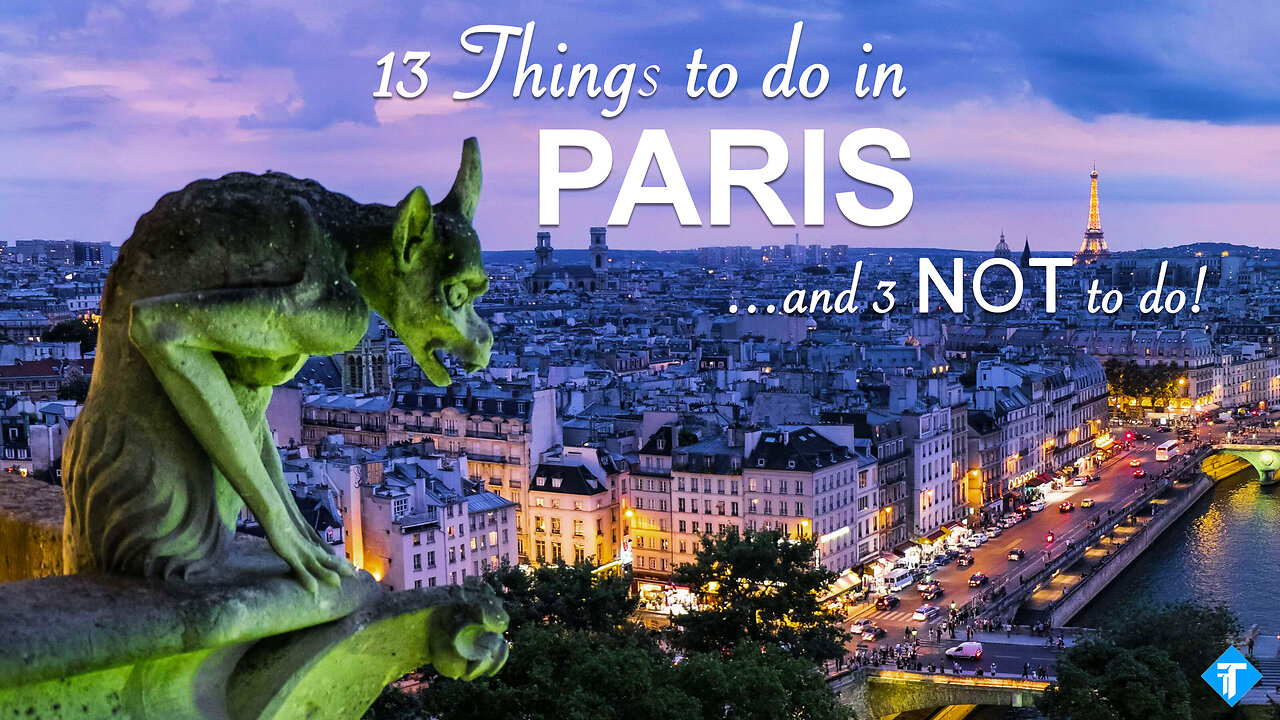Premium Only Content

13 Things to do (and 3 NOT TO DO) in Paris - France Travel Guide
Describing the French capital comprehensively would require not one, but hundreds of articles. Among the data in support of this thesis, perhaps the most emblematic is that of the museums: there are over 150 and each one deserves a visit. Therefore, in the impossibility of seeing everything at once (unless you have enormous resources of time and money) a choice must be made. A choice which in turn should take into account the unique mix of culture, art, history, entertainment and gastronomy that the city offers in large quantities. Below is our personal list of things to do and see in Paris.
1. Tour Eiffel
The story can only start from the Eiffel Tower, the most famous symbol of Paris. Inaugurated in 1889, on the occasion of the X Universal Exhibition (and on the centenary of the French Revolution), this gigantic tower, in the original project, should have been dismantled twenty years after its construction. And instead, not only did it go through the whole of the 20th century, but in the 21st century, thanks above all to the enormous potential of the web, it was definitively consecrated as a global icon, capable of attracting millions of visitors every year. And to think that at the beginning the project was strongly opposed by the Parisian public opinion. There were even those who called it "a threat to French history". Today, on the contrary, anyone wishing to climb to the top, without settling for the classic photo on the Champs de Mars esplanade, must book well in advance. For more information, consult the official website: www.toureiffel.paris/it. Furthermore, not far from the Eiffel Tower, there is the Hotel des Invalides which, in addition to being the largest architectural complex built during the reign of Louis XIV ("Sun King"), houses the tomb of Napoleon Bonaparte. To be seen!
2. Arch of Triumph
After the Eiffel Tower it is the turn of the Arc de Triomphe, another undisputed symbol of Parisian identity. It is located in Place Charles De Gaulle, formerly Place d'Étoile, at the western end of the legendary Champs Élysées, which we will discuss in more detail in the next point. The Arch was strongly desired by Napoleon Bonaparte who entrusted the architect Jean Chalgrin with its construction. However, the latter died in 1811, five years after the beginning of the work, which thus was inaugurated only in 1836, thirty years after the laying of the first stone. The inspiring motif is the Arch of Titus in Rome, even if the Arch of Triumph, emblem of the grandeur of the Napoleonic empire, exceeds the monument of the Flavian era by almost three times. In 1921 at the base of the Parisian Arch the Unknown Soldier was buried in memory of the deceased across the Alps from the First World War. Since then, the Arc de Triomphe has become the starting point for all the most important state parades. Above all that of July 14, commemoration of the Bastille Day. The Arc de Triomphe is located at the confluence of 12 boulevards. We are therefore talking about one of the busiest areas of the capital by far. Therefore, thinking of getting there simply by crossing the street is very dangerous. An underground passage near the Place Charles De Gaulle Metro Station leads up to the entrance of the monument from which, in turn, you go up to the panoramic terrace with one of the most spectacular views of Paris. Here too, given the huge turnout throughout the year, it is preferable to book admission in advance.
3. Champs Élysées
According to many, it is the most beautiful street in the world even if, it must be said, for years now it has been more appreciated and frequented by tourists than by Parisians. The latter flock to the Avenue des Champs Élysées above all on the occasion of official holidays (above all the parade on July 14) and for sporting celebrations involving the city and/or the nation. The road, almost 2 kilometers long, winds its way from the Arc de Triomphe to the Place de la Concorde. It was Queen Maria de' Medici who wanted it to be built at the beginning of the 1600s, with the intention of making it a continuation of the beautiful Jardin Des Tuileres (see next point). The tourist and commercial fortunes of the area began in the second half of the 19th century. The upper part of the avenue – the one, so to speak, which has the Arc de Triomphe as its highest point – is now a temple of luxury shopping: Versace, Dior, Louis Vuitton, Chanel, Jean Paul Gaultier and many others (including Nike and Adidas) have a shop window around here. The lower part, on the other hand, retains a bit of the 19th century Belle Époque atmosphere. Not far away are the Elysee Palace (55 rue du Faubourg-Saint-Honoré), the official residence of the President of the French Republic, and La Madeleine, one of the most beautiful and famous churches in Paris.
4. Tuileries Garden
An unmissable stop on a visit to Paris, the Jardin des Tuileries has several "arrows" to its bow. First of all, it is a beautiful place, born in the 16th century from a "whim" of Caterina de' Medici who, after the construction of the Palazzo of the same name, wanted a place of entertainment for ceremonies and banquets. This in the early days, since later - and we come to the second point in favor -, the garden was opened to all social strata of the city and equipped with cafeterias, kiosks, sunbeds and public hygiene services. Finally, the strategic location: located between the Louvre and Place de la Concorde, this garden represents a real meeting point between two key places in the city, so as to allow the thousands of visitors who visit this part of Paris every day to right relaxation after the "obligatory" visits to museums and monuments. Confirming the centrality of the site, its countless awards. Two above all: a national historic monument since 1914 and a UNESCO World Heritage Site. Not to be missed!
5. Louvre Museum
Giotto, Beato Angelico, Botticelli, Leonardo, Michelangelo, Caravaggio, Parmigianino and many others. The Italian art collection would be enough to qualify the Louvre as the most beautiful museum in the world. But that's not all because there are also exhibitions dedicated to oriental, Egyptian and Greco-Roman art. In short, painting, sculpture and archeology make the Muséè du Louvre an unmissable stop on a visit to Paris. There are millions of visitors who venture into this building every year, containing about 30,000 works of art (the estimate is underestimated). It has been calculated that it would take 100 days to see everything, provided, however, that you dedicate a few seconds to each room. And instead, from Leonardo's "Mona Lisa", to the Nike of Samothrace, up to the Museum dedicated to Eugene Delacroix that can be visited with a single ticket (provided the visit takes place on the same day) the cultural stimuli that the Louvre is able to offer are truly many. Given the impossibility of seeing everything, the advice is to plan the visit in detail with the help of the information on the official website of the structure (www.louvre.fr). Not to be missed!
6. D’Orsay Museum
From a former royal house (Louvre) to a former railway station (d'Orsay) or, if you prefer, from Leonardo, Michelangelo and Titian to Van Gogh, Gaughin and Cezanne. And yes, because the Musée d'Orsay offers one of the most comprehensive overviews of impressionism and post-impressionism in the world. Not only. Urban planning, architecture, design and cinema are the other themes dealt with in this former railway station converted into a museum in 1986 based on a project by the Italian architect Gae Aulenti. For the rest, what has already been said for the Louvre is valid. Given the turnout, advance booking is recommended. More information on the museum's official website: www.musee-orsay.fr (Italian version available). To be seen!
7. Pompidou Center
After the Louvre and the Orsay Museum it is the turn of the Center Pompidou. If the first two, in fact, shed light on the French and European artistic, historical and cultural past, the museum space wanted by the President of the Republic Georges Jean Raymond Pompidou instead illuminates the present and the future of the transalpine nation. Built in the 1970s, this museum has deeply revived Parisian cultural life. Not only for the many works on display (among others, Matisse, Kandinsky, Mirò, Picasso) but precisely because the building as a whole was conceived and built as an element of break with the architecture that had accompanied the urban development of the city. Among other things, and it is an aspect that must also be taken into account, the Center Pompidou is located halfway between the Marais and Les Halle. The former is perhaps the only neighborhood where the medieval Parisian imprint still survives. Once inhabited mainly by Jews, today it is a bohemian area devoted to multiculturalism. Les Halle, on the other hand, is the largest shopping center in the city and is located where the general markets once stood. For more information, consult the website: www.centrepompidou.fr
8. Latin neighborhood
The beating heart of Parisian 1968, Le Quartier Latin extends between the 5th and 6th arrondissements of the city. Therefore, despite the name, it is not a real neighborhood, but a larger area with specific characteristics. The first, of a historical nature, refers to the fact that there was a time when academics and students of the Sorbonne (see photo) actually spoke Latin to each other (hence the name). The second is the presence of the Pantheon, the monument commissioned by Louis XV in honor of Saint Genoveffa (Sainte Geneviève, patroness of Paris). Several prominent personalities are buried inside this monument: among others, Jean Jacques Rosseau, Emile Zola and Victor Hugo. Furthermore, from the dome you can see a wonderful panorama, which repays the effort necessary to get to the top. That's not all, because besides the Sorbonne and the Pantheon, there are several other things to see: the churches of Saint Etienne du Mont and St.Severine, the Institute of the Arab World and Place St. Michel, full of cafés, bookshops and places frequented above all by young people and students. To be seen!
9. Notre Dame
Along with the Eiffel Tower and the Louvre, Notre Dame Cathedral is the most visited monument in Paris. A majestic church dating back to 1163, the year in which the then bishop Maurice De Sully gave the order to build a building that would also symbolize the status of capital of the city on a religious level. The invitation was accepted over time (it took about 2 centuries to complete the church) by thousands of carpenters, blacksmiths, blacksmiths and artists capable of putting together a masterpiece of Gothic art that still today, at a distance hundreds of years old, it fascinates even those who have no history of art at all. It must be said that the church has undergone various alterations over the centuries, the most serious of which certainly occurred during the tumultuous years of the French Revolution. Only in the 19th century, specifically after the literary fortunes of Victor Hugo's novel of the same name ("Notre Dame de Paris"), did the will take over to put an end to the degradation that for years had taken possession of this majestic temple overlooking Ile de la Cité , one of the two river islands of the Seine (the other is Ile de Saint Louise). It goes without saying, the church has hosted several events that have marked the history of France and Europe. Among others: the coronation of Napoleon Bonaparte as emperor and the speech with which General Charles De Gaulle greeted the liberation of France during the Second World War. For more information on the history and visiting hours of Notre Dame Cathedral (UNESCO World Heritage Site since 1991)
10. Versailles
The Palace of Versailles cannot be missing from the appeal of a trip to Paris. There is perhaps no building in the world capable of evoking the idea of power so eloquently without, however, losing harmony and grace. Suffice it to consider two aspects to better focus on what we are talking about: first of all, the fact that the area where Louis XIV (1638-1715) wanted to build the palace was marshy and surrounded by woods. It is no coincidence that Louis XIII, father of the "Sun King", used it as a hunting reserve. The second aspect to keep in mind is the overcrowding that characterized the palace for several years. Louis XIV demanded that the court move almost entirely to Versailles, further sharpening that sense of power and domination we mentioned at the beginning. There are so many things to see that it would take days to get a complete overview. From the Royal Chapel, to the Opera House, passing through the two outbuildings (Grand and Petit Trianon) refuge, respectively, of Louis XIV and Marie Antoinette (wife of Louis XVI), there is really something to take your breath away in the presence of so much magnificence. Absolutely unmissable is the Gallery of Mirrors, a 73-metre-long room (see photo) famous, among other things, for being the place where the First World War ended with the signing of the famous Treaty of Versailles. For more information on the history, opening hours and how to reach the palace which, let us remember, is about twenty kilometers from Paris, consult the official website: www.chateauversailles.fr.
11. Montmartre
Montmartre is another must-see on a visit to Paris. Neighborhood with a strong bohemian soul has long been the refuge of the artistic avant-gardes passing through the city. Not only artists, in truth: the political struggle, combined with a marked intellectual fervor, has always marked the days of this hilly area from which - we recall - the revolt of the Paris Commune started in 1871. For some time, commerce and tourism have replaced artistic experimentation and political passion even if the fascination of locality sui generis, of a real "city within a city", has survived in its inhabitants. There are several things to see: Place du Tertre, the Basilica of the Sacred Heart (see photo), the cemetery of the same name (Montmartre), without obviously forgetting the Moulin Rouge and Pigalle. The latter is the libertine neighborhood par excellence with several red light clubs. It goes without saying that a certain caution is required at night.
12. Senna Boat Tour
Millions of visitors sail the canals of the Seine every year. On board the characteristic Bateaux Mouches (entirely glazed boats, partly open and partly closed) Paris appears even more beautiful than it normally already is. What makes the difference is not only the unusual perspective from the river, but also the time of day in which the excursion is carried out and, even more so, the chosen formula, since the companies that provide the service provide different alternatives : from lunch, to an aperitif at sunset, to dinner (the latter particularly romantic).
13. Disneyland Paris
A list of things to do and see in Paris cannot miss Disneyland Paris, the largest amusement park in Europe (among the top 10 in the world) which since 1992 has attracted millions of visitors a year to the city. To be more precise, a substantial part of these stay in the hotels belonging to the structure; another part, however, combines a visit to the French capital with one or more days dedicated to the park. Park which, despite being in Marne la Vallée, 32 kilometers from the city, is very well connected by underground, bus and shuttle service. Obviously there are many attractions, just think that there are two thematic areas with independent entrances and times. The first, Disneyland Park, is dedicated to Disney fairy tales and characters; the second, however, Walt Disney Studios Park, is dedicated to cinema, animation and special effects. In short, brief hints that, however, already give an idea of how captivating a day at Disneyland Paris can be. It is therefore advisable to plan everything well, relying on the news and advice on the official site: www.disneylandparis.it.
Beware of pickpockets
Don't walk around with your wallet in plain sight in your back pocket, or feel too safe keeping it thrown in bulk in your backpack (or purse). Pickpockets in Paris are numerous and therefore the observance of the normal precautions is recommended in these cases. In addition to those already mentioned, we can add those not to wear bracelets, watches, chains and earrings of particular value, and not to travel late at night in the suburbs of the city.
Watch out for the closing day of the museums
At the beginning we mentioned the enormous number of museums in Paris. Here, however, we point out another aspect: pay attention to the closing day. For example, it is good to remember that the Louvre and Center Pompidou are closed on Tuesdays, while the Musée d'Orsay and the Palace of Versailles are closed on Mondays. In general, therefore, it is preferable to consult in advance the opening/closing times and days of the museum you intend to visit. The simplest thing is to inquire from the official website of each structure. Warn you!
Do not climb (forcibly) the Eiffel Tower
Yes, the Eiffel Tower is one of the must-see things in Paris. And, as we have said, those who are not satisfied with the visit from below, by purchasing the ticket (first), can go up to the top to enjoy a spectacular view of Paris from a height of 300 meters. It must be said, however, that there are several alternatives: one is the Basilica of the Sacré Couer in Montmartre. It's free and the view is just as spectacular.
-
 LIVE
LIVE
FreshandFit
7 hours agoAre You Smarter Than A 5th Grader?
19,056 watching -
 2:45:45
2:45:45
Badlands Media
14 hours agoDevolution Power Hour Ep. 358: Propaganda Wars, Trump's Economic Blueprint, and the Final Narrative Collapse
96K23 -
 2:55:04
2:55:04
TimcastIRL
8 hours agoFBI & GOP EXPOSE "Coup" Against TRUMP, Democrat Operative FELONIES Covered Up | Timcast IRL
235K70 -
 1:05:22
1:05:22
Man in America
16 hours ago5G + mRNA = Remote-Controlled Humanity w/ Dr. Henry Ealy
77.4K57 -
 2:36:23
2:36:23
Geeks + Gamers
8 hours agoGEEKS + GAMERS PLAY- MARIO KART!! SWITCH 2 HYPE!
33.7K1 -
 1:37:44
1:37:44
Badlands Media
1 day agoAltered State S. 3 Ep. 30: Cannabis Crackdowns, Tech Tyranny, and the Battle for the Border
93.9K13 -
 10:01:52
10:01:52
Meisters of Madness
12 hours agoElden Ring - Erdtree Wrap-up
54.8K2 -
 9:22:21
9:22:21
Bitcoin Magazine
2 days agoThe Bitcoin Conference 2025 | Day 2 Livestream
207K27 -
 6:12:41
6:12:41
Eternal_Spartan
6 hours agoLive - Eternal_Spartan | Doom: The Dark Ages | Come Join the Best Rumble Community There Is!!
44.6K2 -
 9:27:07
9:27:07
Dr Disrespect
17 hours ago🔴LIVE - DR DISRESPECT - BATTLEFRONT 2 - TRIPLE XP MADNESS
167K15